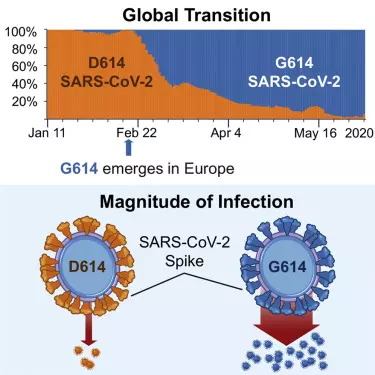You have no items in your shopping cart.
Novel Spike Protein - D614G variant
The current climate for Coronavirus
The original Wuhan strain of COVID-19 is no longer the dominant circulating virus in the global pandemic. A variant carrying a D614G mutation in the Spike (S) protein of SARS-CoV-2 emerged at an early stage of the pandemic and is now one of the prevalent forms (1).
Korber et al reported that this D614G variant may be more virulent with increased patient viral loads but is not associated with a more severe disease outcome. According to Grubaugh et al, the impact of this mutation on the global pandemic is yet unknown and will require further investigation (2).

Image from Korber et al, 2020
SARS-CoV-2 Spike protein D614G variant
Biorbyt are proud to announce the launch of a novel recombinant full-length trimeric soluble SARS-CoV-2 Spike protein D614G variant: A soluble recombinant protein with a foldon trimerization motif, mutated Furin recognition site and 2 stabilising mutations (K986P and V987P), based on/modified from Amanat et al, 2020 (3).
Understanding the D614G mutation
The D614G mutation is in the S1 subunit of the Spike protein. The S protein monomer consists of two active subunits, the S1 subunit which binds the host receptor and the S2 subunit which facilitates fusion of viral and host cell membranes. The S protein monomers combine to form the distinctive homotrimers which project from the viral cell surface. Viral entry into the host cell is via the ACE2 receptors located on the host cell membrane (4,5). The spike protein is highly immunogenic and most of the vaccines and therapeutic agents currently in development target this region.
Focus on Quality
The highly validated recombinant full-length trimeric SARS-CoV-2 Spike protein, D614G variant (amino acids 16-1213) is produced in HEK293 cells and supplied in liquid format. Endotoxin levels are less than 0.1 ng/μg (1 IEU/μg), and purity >90% as estimated by SDS-PAGE. A C-terminal 8x histidine Tag has been added to the protein for ease of use.
References
Korber et al., Tracking Changes in SARS-CoV-2 Spike: Evidence that D614G Increases Infectivity of the COVID-19 Virus, Cell (2020), https://doi.org/10.1016/j.cell.2020.06.043
Grubaugh et al., Making Sense of Mutation: What D614G Means for the COVID-19 Pandemic Remains Unclear, Cell (2020), https://doi.org/10.1016/j.cell.2020.06.040
Amanat, F., Stadlbauer, D., Strohmeier, S., et al. A serological assay to detect SARS-CoV-2 seroconversion in humans. Nat Med., 2020;26:1033–1036.
Walls et al., Structure, Function, and Antigenicity of the SARS-CoV-2 Spike Glycoprotein 2020, Cell, 180, 281–292.
Hoffmann M., Kleine-Weber H., Schroeder S., et al. SARS-CoV-2 Cell Entry Depends on ACE2 and TMPRSS2 and Is Blocked by a Clinically Proven Protease Inhibitor. Cell, 2020;181(2):271-280

